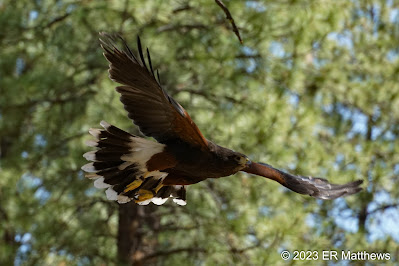Last year in our visit to the High Desert Museum just south of Bend, we promised ourselves that we would become members this year and visit more often, if for no other reason than watching the daily raptor flights is fascinating. With the kids due to visit at the end of June, we wanted to go ahead and get our membership squared away, so yesterday we made the less than 10-minute drive to the museum.
We are just rolling into spring after a very cold and snowy winter, so there are not a lot of wildflowers in bloom just now at the museum compared to later in the year. Still, this is as early as I have seen any Forget-me-nots in bloom; along the river, the plants are just coming up and none are thinking about flowering. You can see below one other sign of spring: a lush patch of Stinging Nettles just coming up reminding me that I sure would love a stinging nettle and potato pizza.
 |
| Stunning Western Serviceberry, Amelanchier alnifolia |
 |
| Early Forget-Me-Nots, Myosotis scorpioides |
 |
| Aspens, Populus tremuloides, Finally Have Leaves |
 |
| Antelope Bitterbrush, Purshia tridentata, in Full Bloom |
 |
| Spreading Phlox, Phlox diffusa |
 |
| Western Wallflower aka Prairie Rocket, Erysimum capitatum |
 |
| Virginia Strawberry, Fragaria virginiana |
 |
| Young Nettles Just Wanting to be Cooked, Urtica dioica |
The museum grounds are usually overrun by rodents, both the tiny Yellow-pine Chipmunk and the fatter and larger Yellow-mantled Ground Squirrel, but not currently this early in the season. So far this year, I've seen but a single chipmunk, but not one at the museum. We did see a few ground squirrels including two that seemed to be duking it out over some disputed turf. I also saw a tiny Douglas' Squirrel toting an entire mushroom in its mouth; the mushroom was a third the size of the tiny rodent.
 |
| Golden-Mantled Ground Squirrel Surveying its Turf |
 |
| Aggressive Posture after Fighting a Rival |
 |
| Western Fence Lizard Basking |
For Ann and me, the museum's primary attraction is viewing the resident birds which fly each morning at 11:30 in a program called
Raptors of the Desert Sky. I might object on technical grounds to Turkey Vultures being called raptors, but they are beautiful, graceful fliers and I love watching them. As long-range soarers, they are not built for the short flights during the exhibition, which must be really tiring for them, unused as they are to flapping their wings.
 |
| Swainson's Hawk |
The first bird in the program was a Swainson's Hawk, a bird that I have never stopped to identify in the wild. I have no doubt seen plenty of them on the prairies out where we live, sitting on fences, poles, and irrigation rigs, but I've never taken the time to make sure of the ID. The bird in the photo above hit me in the head with its wing as it flew by.
Next up in the program was a pair of Harris' Hawks, also birds I have never seen in the wild because they live in the desert along the US-Mexico border and not around here. I just love their striking plumage and so if they are overrepresented in the photos in this post, it will be because they are phenomenal looking birds.
 |
| Female Harris' Hawk |
 |
| Both Hawks in Same Frame |
The following four photos are consecutive frames of a female Harris' Hawk taking flight.
Vultures, both Turkey and Black (which live in the Southeast), get a bad rap as carrion eaters. I think they are beautiful birds nonetheless and am envious of the seeming ease with which they can soar on thermals all day with never a wing beat.
 |
| Female Turkey Vulture |
The undisputed star of the show is the avian fighter jet equivalent, the vaunted Peregrine Falcon. If this female is underrepresented in the photos, it's because she flies too damn fast for still photography, at least with my equipment and skill. This one, recovering from a broken wing, flies significantly slower than the one on display last year which flew nearly twice as fast.
 |
| Peregrine on the Wing |
 |
| Peregrine in the Hand |
After the aerial portion of the show, the museum staff bring out other birds on the hand for patrons to see up close. On this visit, we saw a small and atypically (in my experience) brown Great Horned Owl rescued from northern California as well as a striking Gyrfalcon, the largest falcon species, one which lives way north of us in the arctic and Canada.
 |
| Small Male Great Horned Owl |
 |
| Striking Gyrfalcon |
The other prime attraction on the museum grounds are the silly River Otters which always put on a show doing what otters do best: playing.
The High Desert Museum is one of the principal things that tourists want to see when they visit Bend and for good reason. We are very eager to show off this resource to the kids when they come in late June.


































No comments:
Post a Comment